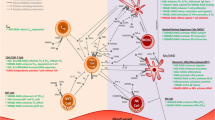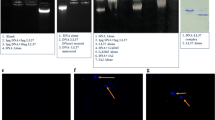Abstract
Introduction
Advanced glycation endproducts (AGEs) are well-known inflammatory mediators, which are recognized by immune cells through their corresponding receptor RAGE and have been shown to participate in the pathophysiology of a variety of acute as well as chronic inflammatory diseases. Nevertheless, no data are available on the aftermath of AGE recognition on immune cells.
Materials and methods
We used the monocytic cell line MonoMac6 as well as primary human monocytes for double stimulation experiments. We measured secreted as well as intracellular levels of TNF-α using ELISA and flow cytometry. In addition, gene expression of surface receptors (RAGE and TLR4) and TNF were measured by qPCR.
Results
Stimulation with AGE leads to a dose-dependent induction of self- and cross-tolerance in both primary monocytes as well as the MonoMac6 cell line. The AGE tolerance depended neither on a decreased expression of RAGE or TLR4, nor on a decrease of TNF-α expression. Nevertheless, intracellular TNF-α was decreased, hinting towards a posttranscriptional regulation.
Conclusion
High levels of AGEs are capable to activate immune cells at first, but induce a secondary state of hypo-responsiveness in these cells. Based on the origin of its causal agent, we propose this phenomenon to be “metabolic tolerance”.





Similar content being viewed by others
References
Takeuchi O, Akira S. Pattern recognition receptors and inflammation. Cell. 2010;140(6):805–20.
Bianchi ME. DAMPs, PAMPs and alarmins: all we need to know about danger. J Leukoc Biol. 2007;81(1):1–5.
Grivennikov SI, Karin M. Dangerous liaisons: STAT3 and NF-κB collaboration and crosstalk in cancer. Cytokine Growth Factor Rev. 2010;21(1):11–9.
Schmidt AM, Yan SD, Yan SF, Stern DM. The multiligand receptor RAGE as a progression factor amplifying immune and inflammatory responses. J Clin Invest. 2001;108(7):949–55.
Buckley ST, Ehrhardt C. The receptor for advanced glycation end products (RAGE) and the lung. J Biomed Biotechnol. 2010;2010:917108.
Xie J, Méndez JD, Méndez-Valenzuela V, Aguilar-Hernández MM. Cellular signalling of the receptor for advanced glycation end products (RAGE). Cell Signal. 2013;25(11):2185–97.
Singh R, Barden A, Mori T, Beilin L. Advanced glycation end-products: a review. Diabetologia. 2001;44(2):129–46.
de Courten B, de Courten MP, Soldatos G, Dougherty SL, Straznicky N, Schlaich M, et al. Diet low in advanced glycation end products increases insulin sensitivity in healthy overweight individuals: a double-blind, randomized, crossover trial. Am J Clin Nutr. 2016;103(6):1426–33 (American Society for Nutrition).
Beeson PB. Development of tolerance to typhoid bacterial pyrogen and its abolition by reticulo-endothelial blockade. Proc Soc Exp Biol Med. 1946;61:248–50.
Virca GD, Kim SY, Glaser KB, Ulevitch RJ. Lipopolysaccharide induces hyporesponsiveness to its own action in RAW 264.7 cells. J Biol Chem. 1989;264(36):21951–6.
Uhle F, Lichtenstern C, Brenner T, Fleming T, Koch C, Hecker A, et al. Role of the RAGE Axis during the Immune Response after Severe Trauma: A Prospective Pilot Study. Mediators Inflamm. 2015;2015:691491 (Hindawi Publishing Corporation).
Brenner T. Methylglyoxal as a new biomarker in patients with septic shock: an observational clinical study. Crit Care. 2015;18(6):1–11.
Otto GP, Sossdorf M, Claus RA, Rödel J, Menge K, Reinhart K, et al. The late phase of sepsis is characterized by an increased microbiological burden and death rate. Crit Care. 2011;15(4):R183 (BioMed Central Ltd).
Kimura F, Shimizu H, Yoshidome H, Ohtsuka M, Miyazaki M. Immunosuppression following surgical and traumatic injury. Surg Today. 2010;40(9):793–808.
López-Collazo E, del Fresno C. Pathophysiology of endotoxin tolerance: mechanisms and clinical consequences. Crit Care. 2013;17(6):242.
Pena OM, Pistolic J, Raj D, Fjell CD, Hancock REW. Endotoxin tolerance represents a distinctive state of alternative polarization (M2) in human mononuclear cells. J Immunol. 2011;186(12):7243–54.
Aneja R, Odoms K, Dunsmore K, Shanley TP, Wong HR. Extracellular heat shock protein-70 induces endotoxin tolerance in THP-1 cells. J Immunol. 2006;177(10):7184–92.
Jacinto R, Hartung T, McCall C, Li L. Lipopolysaccharide- and lipoteichoic acid-induced tolerance and cross-tolerance: distinct alterations in IL-1 receptor-associated kinase. J Immunol. 2002;168(12):6136–41.
Mizel SB, Snipes JA. Gram-negative flagellin-induced self-tolerance is associated with a block in interleukin-1 receptor-associated kinase release from toll-like receptor 5. J Biol Chem. 2002;277(25):22414–20.
Dillon S, Agrawal S, Banerjee K, Letterio J, Denning TL, Oswald-Richter K, et al. Yeast zymosan, a stimulus for TLR2 and dectin-1, induces regulatory antigen-presenting cells and immunological tolerance. J Clin Invest. 2006;116(4):916–28.
Günther J, Vogt N, Hampel K, Bikker R, Page S, Müller B, et al. Identification of two forms of TNF tolerance in human monocytes: differential inhibition of NF-κB/AP-1- and PP1-associated signaling. J Immunol. 2014;192(7):3143–55.
Austermann J, Friesenhagen J, Fassl SK, Ortkras T, Burgmann J, Barczyk-Kahlert K, et al. Alarmins MRP8 and MRP14 induce stress tolerance in phagocytes under sterile inflammatory conditions. Cell Rep. 2014;9(6):2112–23.
Aneja RK, Tsung A, Sjodin H, Gefter JV, Delude RL, Billiar TR, et al. Preconditioning with high mobility group box 1 (HMGB1) induces lipopolysaccharide (LPS) tolerance. J Leukoc Biol. 2008;84(5):1326–34.
Lantos J, Földi V, Rőth E, Wéber G, Bogár L, Csontos C. Burn trauma induces early HMGB1 release in patients: its correlation with cytokines. Shock. 2010;33(6):562–7.
Hofer S, Uhle F, Fleming T, Hell C, Schmoch T, Bruckner T, et al. RAGE-mediated inflammation in patients with septic shock. J Surg Res. 2016;202(2):315–27.
Li JF, Schmidt AM. Characterization and functional analysis of the promoter of RAGE, the receptor for advanced glycation end products. J Biol Chem. 1997;272(26):16498–506.
El Gazzar M, Yoza BK, Hu JYQ, Cousart SL, McCall CE. Epigenetic silencing of tumor necrosis factor alpha during endotoxin tolerance. J Biol Chem. 2007;282(37):26857–64.
O’Neill L. MicroRNAs: the fine-tuners of Toll-like receptor signalling. Nat Rev Immunol. 2011;11(3):163–75.
Singh RP, Massachi I, Manickavel S, Singh S, Rao NP, Hasan S, et al. The role of miRNA in inflammation and autoimmunity. Autoimmun Rev. 2013;12(12):1160–5.
Gerlach B, Cordier SM, Schmukle AC, Emmerich CH, Rieser E, Haas TL, et al. Linear ubiquitination prevents inflammation and regulates immune signalling. Nature. 2011;471(7340):591–6.
Cheng S-C, Scicluna BP, Arts RJW, Gresnigt MS, Lachmandas E, Giamarellos-Bourboulis EJ, et al. Broad defects in the energy metabolism of leukocytes underlie immunoparalysis in sepsis. Nat Immunol. 2016;17(4):406–13.
Author information
Authors and Affiliations
Author notes
Florian Uhle and Sebastian Weiterer are first authors.
Contributions
F.U., T.B., C.L., M.A.W.: design and organization of the experiments, performed experiments, data analysis and collection, interpretation of the results and writing of the manuscript. S.W., B.S.: performed sample measurements, interpretation of results and critical revision of the manuscript.
Corresponding author
Ethics declarations
Conflict of interest
The authors declare that there is no conflict of interest regarding the publication of this manuscript. The study was not funded.
Additional information
Responsible Editor: Artur Bauhofer.
Electronic supplementary material
Below is the link to the electronic supplementary material.
11_2017_1076_MOESM1_ESM.tiff
Supplementary Fig. 1: Dependency of tolerance induction on glycation and RAGE receptor. (A) MM6 cells were primed for 24 h with unmodified BSA, AGE-modified BSA or LPS for 24 h and re-stimulated with the same compounds for additional 24 h. Supernatant TNF-α was assessed by ELISA and graph shows mean ± SEM, n = 3. (B) MM6 cells were primed (or left unprimed) in the presence of RAGE inhibitor 230 nM FPS-ZM1 for 24 h and re-stimulated with AGE for additional 24 h. Supernatant TNF-α was assessed by ELISA and graph shows mean ± SEM, n = 4. *: p ≤ 0.05. (TIFF 325 kb)
11_2017_1076_MOESM2_ESM.tif
Supplementary Fig. 2: Impact of LPS- and AGE-tolerance on the production of different cytokines. MM6 cells were primed with increasing doses of either LPS or AGE for 24 h and subsequently re-stimulated with LPS (left column) or AGE-BSA (right column) for further 24 h. Graph shows mean ± SEM, n = 3. (TIFF 5462 kb)
Rights and permissions
About this article
Cite this article
Uhle, F., Weiterer, S., Siegler, B.H. et al. Advanced glycation endproducts induce self- and cross-tolerance in monocytes. Inflamm. Res. 66, 961–968 (2017). https://doi.org/10.1007/s00011-017-1076-9
Received:
Accepted:
Published:
Issue Date:
DOI: https://doi.org/10.1007/s00011-017-1076-9




